The Leading Edge: January 2022 Wind Energy Newsletter
In this edition, AWAKEN to a new study, trace a researcher's career back to a solar panel in India, and read the latest cost of wind energy review.
News Stories
A New Study AWAKENs a Chance To Save Wind Power Plants Millions
Recently, a team of researchers launched the American WAKE experimeNt (AWAKEN), an international, multi-institutional wind energy field campaign NREL is working on in collaboration with the Pacific Northwest National Laboratory and Sandia National Laboratories to create the world's most comprehensive data set of atmospheric phenomena in and around wind turbines. This study will build on previously designed models and simulations that estimate how winds might move through wind power plants.
To confirm the accuracy of these simulations, from the summer of 2021 through October 2023, the team will gather observational data using sensors, drones, and manned aircraft in and around operational wind plants. Once complete, those data could help developers improve their plants' energy production and profits.
Wind farm losses can result from turbine-to-turbine wake interactions, but the models that predict those have great uncertainties. AWAKEN, funded by the U.S. Department of Energy (DOE) Wind Energy Technologies Office (WETO), could cut that by as much as half, improving wind plant predictions and planning.
Wind win! How air currents move through wind plants is not well understood. That's
why the AWAKEN research team is using scanning radars, lasers, and aircraft to map
how winds flow between and around wind turbines and provide critical data that could
help developers increase their plant's revenues and energy production. Animation by Josh Bauer, NREL
Text version
Understanding the Impact of Wind Conditions on Concentrating Solar Power Structures
NREL and DOE's Solar Energy Technologies Office, along with several partners and stakeholders, have kicked off a new study to measure atmospheric turbulent wind conditions at concentrating solar power structures and understand how wind impacts their load bearing. The team will collaborate with wind energy researchers at NREL and use high-fidelity computational-fluid-dynamic models and instruments that have been developed for on-site wind assessment with funding from WETO.
A measurement campaign at the Nevada Solar One facility gathers data on wind conditions
and loads on concentrating solar power structures. Photo by Shashank Yellapantula, NREL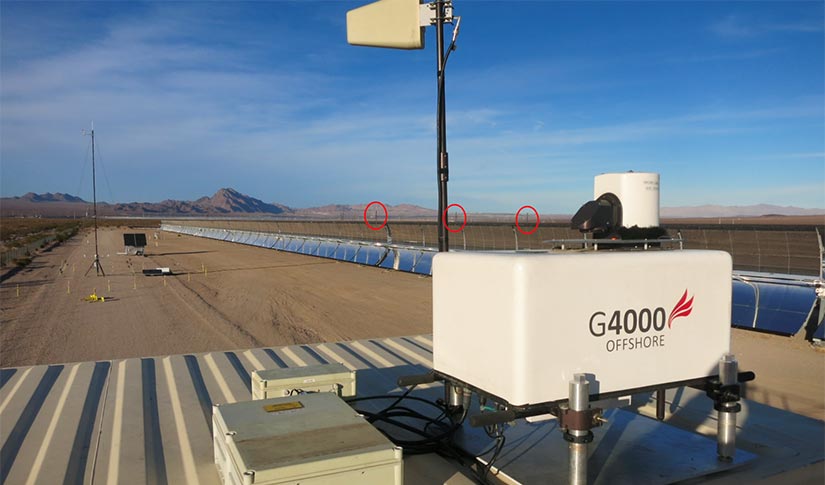
Behind the Blades
Behind the Blades: The Humble Origins of a Renewable Energy Career
Mithu Debnath grew up in a rural village in Bangladesh without electricity. He recalls walking to the home of a couple who lived a few miles away to see with his own eyes a solar panel, which had the capability of powering a single, 30-watt lightbulb. With each step, he contemplated how the cost of that solar panel could be reduced so that his family could afford one.
"I am pleased that renewable energy has come so far," said Debnath, who now helps to decrease the cost of wind energy. "But it needs to go a long way to utilize the resources of remote places to power rural communities and local businesses as a cost-effective solution."
Debnath has earned bachelor's, master's, and doctoral degrees in mechanical engineering and now specializes in atmospheric science and its application to wind energy. Through his research at NREL, he focuses on identifying the influence of atmospheric flows on wind plants and vice versa, using remote-sensing methods to observe what happens at wind plants and coupling that data with computational models to improve predictive tools. Recently, he co-authored a publication with four collaborators that exemplifies how observational data contribute to understanding atmospheric flows and their potential influences on wind energy.
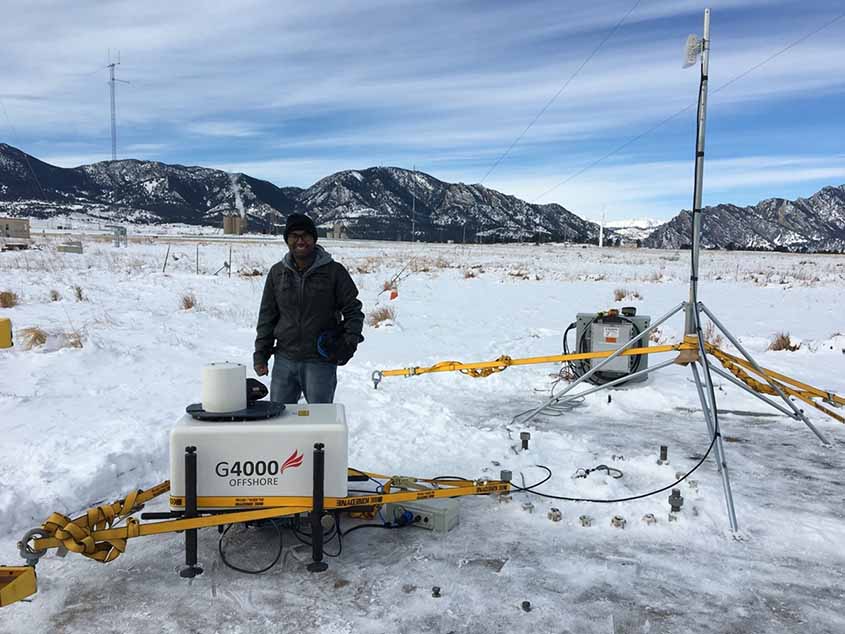
Mithu Debnath uses remote-sensing instruments, like this lidar device, and different in situ sensors to observe interactions between the atmosphere and wind turbines both on land and offshore. Photo by Andrew Scholbrock, NREL
The potential to collaborate with phenomenal researchers and industry partners to maximize innovation in wind energy technologies was actually what drew Debnath to NREL. In particular, he was fascinated with the open-source potential of the Simulator for Wind Farm Applications tool, which combines solvers and models to enable users to evaluate wind turbine and plant performance in various atmospheric conditions.
"I realized that open-source data, tools, and codes are the keys to support the rapid growth of wind energy," Debnath explained. "Unlike other fundamental research, wind energy research can immediately impact the industry and needs effective coordination and collaboration with the industry."
Debnath is also a member of the team behind the newly launched AWAKEN. AWAKEN is part of DOE's larger Atmosphere to Electrons research and development initiative, which focuses on improving the efficiency of wind energy by better understanding the physics in and around wind power plants.
Through AWAKEN and other projects in his career, Debnath remains true to the inspiration he gained from that one solar panel in Bangladesh. "I am proud that I have not forgotten my commitment and am still contributing to renewable energy," he said. "With so many helpful colleagues at NREL, I hope to grow more every day."
On the Radar
2020 Cost of Wind Energy Review
In the "2020 Cost of Wind Energy Review," NREL wind energy researchers share their estimates on the cost of wind energy. And the good news? It's decreasing.
The 10th edition of the annual report estimates the levelized cost of energy (LCOE) for U.S. residential- and commercial-scale distributed wind and representative land-based and offshore wind power plants.
Based on U.S. commissioned plants and wind resource information in 2020, along with the aid of state-of-the-art modeling capabilities and data accumulated throughout the global wind energy industry, the report notes the following downward trends in cost estimates:
- Land-based wind power plant LCOE estimates continue to show a downward trend, with installations observed to be $34/MWh, down from $37 per megawatt-hour (MWh), as reported in the 2019 review, and a 59% decrease from the 2010 report.
- Offshore wind power plant LCOE estimates continue to decrease at $77/MWh for fixed-bottom projects and $129/MWh for floating projects, which compares to $85/MWh and $132/MWh, respectively, in 2019—or a 71% decrease from the 2010 report for fixed-bottom offshore wind.
- The LCOE estimates for reference residential and commercial distributed wind energy projects are estimated at $151/MWh and $99/MWh, respectively, both dropping since 2019 when the estimates were $159/MWh and $104/MWh.
Aiding developers, researchers, investors, and utility workers alike, the results of this review offer estimates for the costs of representative wind energy projects across the United States down to component-level detail.
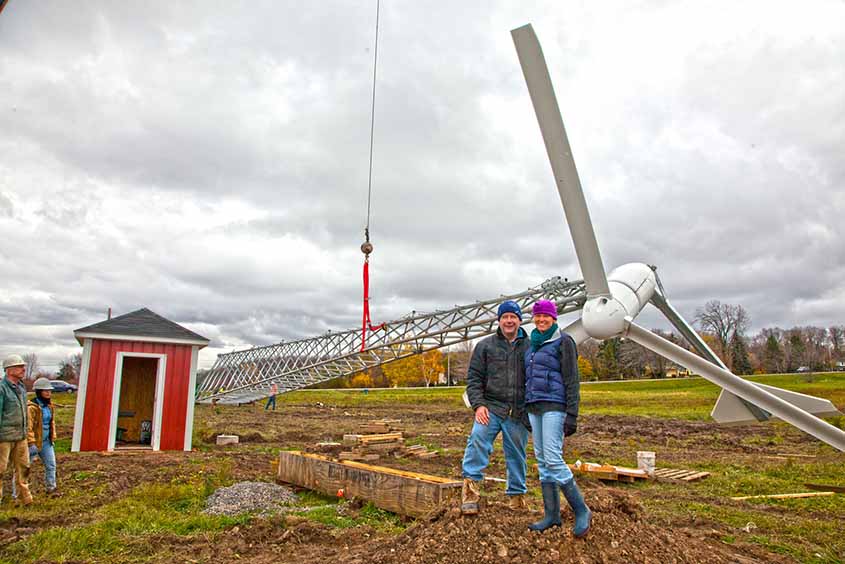
Proud Arrowhead Spring Vineyards owners install a Bergey 10-kilowatt turbine on a 120-foot tower in Lockport, New York. Photo from Niagra Wind & Solar Inc.
NREL To Invite Proposals for Distributed Wind Innovation in 2022
NREL intends to release a request for proposals for the 2022 Competitiveness Improvement Project, managed by NREL on behalf of DOE, in the first quarter of 2022. The distributed wind energy industry requires rapid innovation to reduce costs and increase customer confidence, but many companies that build small and midsized wind turbines do not have the resources to develop and certify next-generation technology. The Competitiveness Improvement Project provides financial and technical support to U.S.-based wind turbine manufacturers, and in turn, selected projects can help reduce the levelized cost of energy and accelerate distributed wind energy deployment in the United States.
NREL Offshore Wind Proposal Wins $480,000 Award
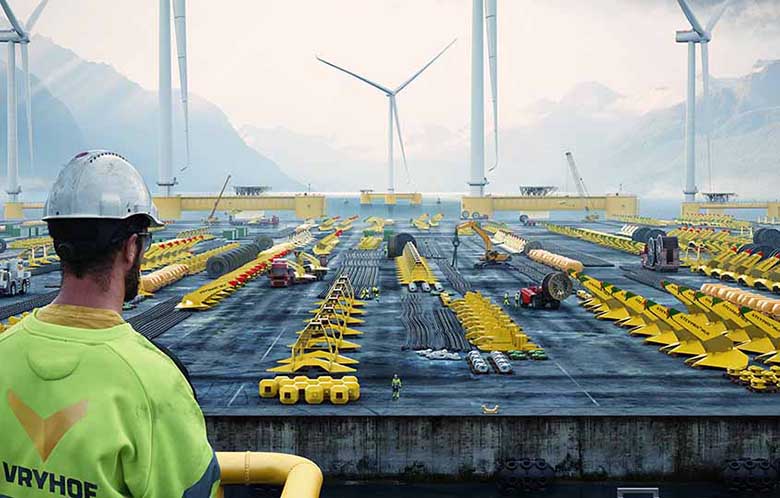
Harnessing offshore wind off the U.S. West Coast will require new mooring and anchoring solutions that improve economies of scale and fully leverage local supply chains. National Wind Technology Center researchers aim to develop those solutions with funding from the National Offshore Wind Research and Development Consortium. Image from Vryhof
An NREL proposal, "Standardized Scalable Mooring Solutions Optimized for the U.S. Supply Chain," was among six projects selected to be awarded a total of $3.4 million in funding from the National Offshore Wind Research and Development Consortium's Innovation in Offshore Wind competitive solicitation. In collaboration with Delmar Systems, its subsidiary Vryhof, and the California Governor’s Office of Planning and Research, two NREL researchers will work to design new mooring and anchoring systems suitable for large-scale wind plants off the West Coast of the United States. Those solutions will be standardized and optimized to enable mass production and leverage the domestic supply chain, thereby mitigating supply chain obstacles to the deployment of floating wind energy projects while lowering costs and increasing local benefits.
Upcoming Webinar on Wildlife and Wind Energy
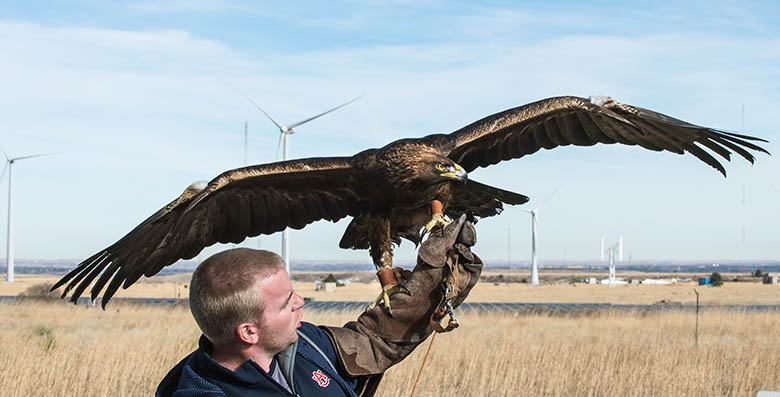
An eagle at NREL’s Flatirons Campus helps the lab develop radar and visual systems that prevent bird strikes with wind turbines. Photo by Dennis Schroeder, NREL
On Feb. 8, 2022, an NREL researcher will join others from the government and industry to discuss the U.S. Offshore Wind Synthesis of Environmental Effects Research project, an effort jointly supported by WETO, Pacific Northwest National Laboratory, and NREL. The project is sponsoring this free webinar, which is open to the public and will summarize interactions between bats and birds with offshore wind turbines, including studies on wildlife behavior around wind power plants and technologies that can improve monitoring and mitigation. Register to attend via Zoom.
Downwind: In Case You Missed It
Webinar on Offshore Wind Energy: Technology Above the Water
In a December 2021 WINDExchange webinar, NREL's offshore wind energy research lead, Walt Musial, presented an overview of the technology involved in offshore wind above the water, including wind power plant technology, turbine technology, and wind resource assessments and modeling. The webinar provides foundational technical information to communities and interested stakeholders. Watch the recording and follow along in the presentation.
New Report Provides Strategies To Expand Regional and National Offshore Wind Energy
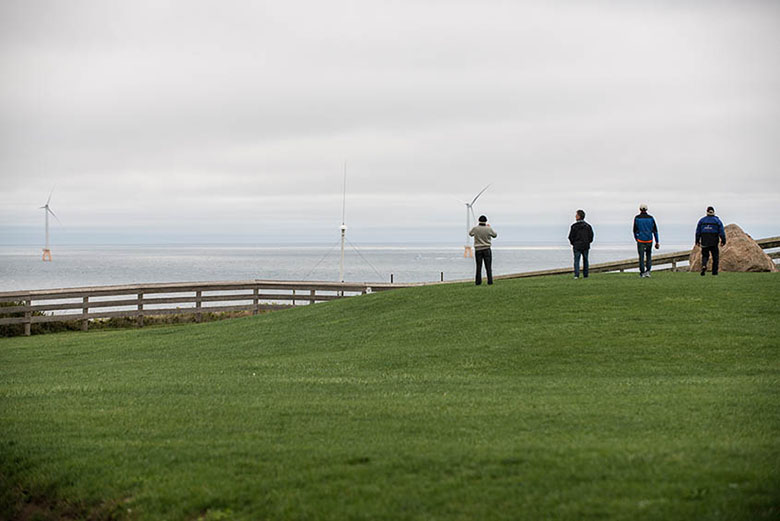
The Block Island Wind Farm is the first U.S. offshore wind farm, as seen from Block Island, which came online with five turbines in December 2016. Photo by Dennis Schroeder, NREL
DOE has released the "Offshore Wind Energy Strategies" report, with author, preparation, and contribution support from many in NREL's wind energy team. Examining the potential and challenges to accelerate and maximize wind energy in the United States, the report outlines regional and national strategies for deployment and operation as well as effectiveness, sustainability, and reliability. Intended to be evaluated by members of the government, industry, academia, and tribes, in addition to stakeholders and wind energy users, the report could help the nation become a global leader in wind energy.
NREL Shares Top 20 News Articles of 2021
Among the top 20 most-read articles that NREL posted in 2021, two give a glimpse at some of wind energy's accomplishments. One of the most-read articles describes results from the Interconnections Seam Study, which found benefits to the U.S. grid by increasing the capacity of transmission between the Eastern and Western Interconnections. Another article that made the top-20 list highlights two NREL projects that won an R&D 100 award. One of these, dGen, is a model that simulates customer decisions about using renewable energy resources such as wind to forecast power system demand. Both the study and the model are supported, in part, by WETO.
NREL Wind Energy in the News
Bangladesh Bets Big on Wind Energy To Curb Climate Change
Referencing the city's wind energy production potential, estimated in a 2014–2017 study conducted by NREL and the United States Agency for International Development, an article in the Dhaka Tribune announces Bangladesh's intention to expand its renewable energy generation with 5,000 megawatts of land-based and offshore wind power by 2030.
U.S. Department of Energy Calls for Expanding Federal Incentives for Offshore Wind
The website offshorewind.biz shared DOE's report on strategies for offshore wind energy, calling out targeted federal incentives that could stimulate the demand for wind energy in the United States as well as mentioning four other priorities intended to improve the renewable energy's prevalence.
Wind Turbine With Advanced Controls Used in Grid-Forming Test by NREL and General Electric
An article posted by Power Engineering referred to a recent NREL news story highlighting the first demonstration of Type-3 wind turbine technology operating in grid-forming mode, an effort by NREL and General Electric that enables it to restart from an outage among other benefits.
Recent Publications
Acoustic Exposure to Turbine Operation Quantifies Risk to Bats at Commercial Wind Energy Facilities
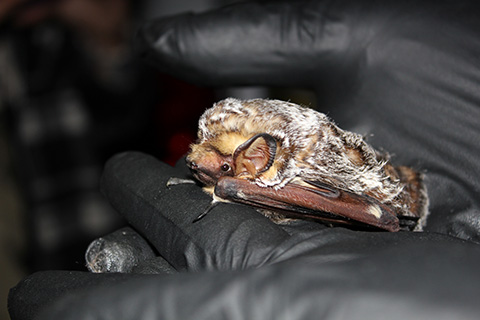
A newly published study collected 7 years of data on the activity of bats, like this hoary bat, around wind turbines at two commercial wind power plants in West Virginia. Photo by Cris Hein, NREL
Curtailing—slowing the rotational speed of wind turbine blades during low wind speeds—is one strategy for reducing wind energy impacts to bat populations but can result in a loss of wind power generation. New approaches to curtailment that incorporate wind speed plus additional factors, such as temperature or bat activity, may protect bats while improving power production. To determine whether acoustic bat data recorded at turbine nacelles could provide a more precise and sensitive measure of risk to bats, a University of Maine doctoral candidate, with support from NREL and other co-authors, analyzed data collected from two commercial wind energy facilities in West Virginia over a period of 7 years. Analysis of the data indicated that bat activity during times when turbine blades are spinning has a strong relationship to estimates of bat impact rates. Those results demonstrate that measuring exposure of acoustic bat activity provides a quantitative basis for designing, evaluating, and adaptively managing curtailment strategies. This is an important step toward using curtailment to strategically reduce wind energy impacts to bat populations while enabling increased generation of renewable energy.
Up-Tower Investigation of Main Bearing Cage Slip and Loads
Premature main bearing failures can cause significant wind plant operation and maintenance costs. To find solutions for reducing those costs, NREL researchers described measurements of roller load-induced behavior on the General Electric 1.5-megawatt SLE model wind turbine at the Flatirons Campus and used those measurements to examine factors that might impact main bearing health, such as cage slip. The team predicted normal bearing contact pressures and found no indications of cage slip; however, these parameters are useful for comparison with bench-level tests of bearing contact conditions that have been shown to contribute to premature wear and fatigue. This work builds on a previous examination of the effect of axial motion on main bearing wear of an instrumented spherical roller main bearing in the same turbine, which found the axial velocity of the rollers compared to their rolling speed to be negligible and thus not expected to influence lubricant film thickness and bearing wear. Future analyses will examine more direct measurements indicative of the lubricant film thickness and potential asperity contact between the bearing rollers and raceways.
Scaling Trends for Balance-of-System Costs at Land-Based Wind Power Plants: Opportunities for Innovations in Foundation and Erection
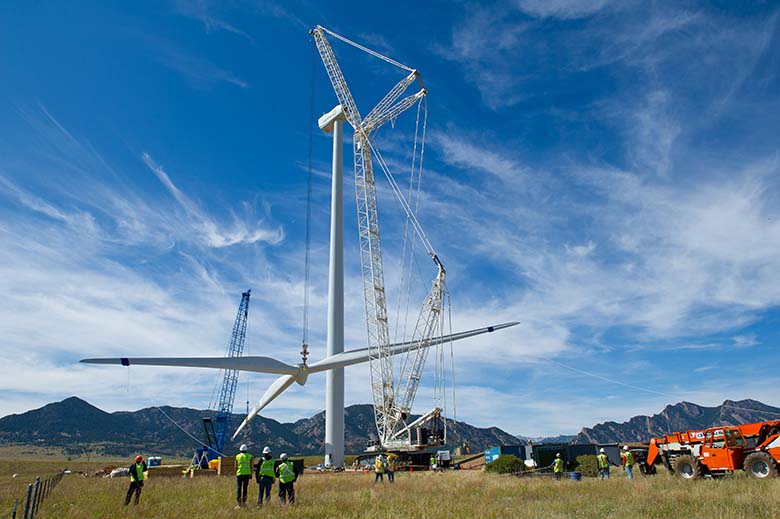
Workers prepare to lift a blade assembly on the 2-megawatt Gamesa wind turbine using a giant crane during installation at NREL’s Flatirons Campus in 2011. Photo by Dennis Schroeder, NREL
The cliché "bigger is better" seems to have been applied to wind turbines and wind energy plants as blades elongate, towers grow taller, and plants expand to larger numbers of turbines. All adjustments have been made to capture more and greater wind resources and produce more energy per turbine or per plant, lowering the cost of energy capture. However, it is unclear how wind power plant costs might change as wind turbines and wind power plants continue to increase beyond their current sizes. In some cases, going bigger can inflate installation (balance-of-system) costs for wind energy developers, which may increase the cost of energy. Now, in a journal article published in Wind Engineering, NREL researchers have evaluated how the costs to install these larger systems might influence their LCOE. By tweaking parameters for a baseline reference plant using NREL's Land-based Balance of System Systems Engineering model, the team's analysis shows that increasing plant sizes, employing alternative cranes and towers, or decreasing foundation costs can lower balance-of-system costs as systems increase in size. Those results can help researchers, developers, and policymakers evaluate the opportunity space for balance-of-system innovations and identify needs for future research and development that might enable these cost-reduction trends to continue as wind energy systems go even bigger.
A Review of Modeling Techniques for Floating Offshore Wind Turbines
Numerical modeling and physical scale-model testing both play an essential role in advancing the development of floating offshore wind turbine designs toward commercialization. However, modeling those turbines is challenging due to the strong coupling between the aerodynamics of the turbine and the hydrodynamics of the floating platform. A variety of numerical and physical modeling approaches are currently in use, both independently and using a cross-validation approach to derisk the commercial development of concepts through the technology readiness levels. An article published in Wind Energy, coauthored by an NREL researcher, provides an overview of both numerical modeling and physical floating offshore wind turbine scale-model testing approaches. This overview will help guide floating offshore wind turbine designers in selecting the most appropriate modeling approaches for their designs.
Linearized Modeling and Optimization of Shared Mooring System
Shared mooring systems, wherein adjacent platforms are tethered directly to each other, can reduce anchor quantities and mooring line lengths in a floating wind turbine array but also introduce new modeling and design challenges. In this Ocean Engineering article, NREL researchers present and demonstrate a first-order approach to modeling and designing shared mooring systems that simplifies those challenges. The research team formulated a general, linearized model for the force-displacement response of shared mooring systems. Using this linearization, the team found significant simplifications to the shared mooring system design problem, proposed a corresponding design optimization approach, and demonstrated the complete approach on a variety of shared-mooring floating wind power plant layouts with generic design assumptions and constraints. Results show how the linearized approach can be applied to efficiently evaluate and systematically optimize preliminary shared mooring system designs.
Want More?
Subscribe to The Leading Edge newsletter, and explore the latest news and accomplishments in wind energy at NREL.
Share

